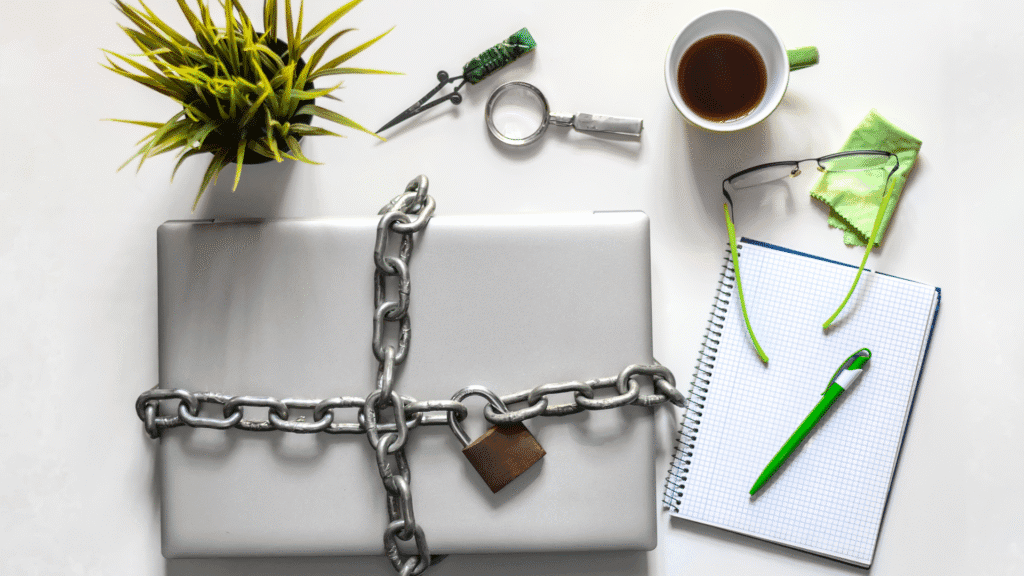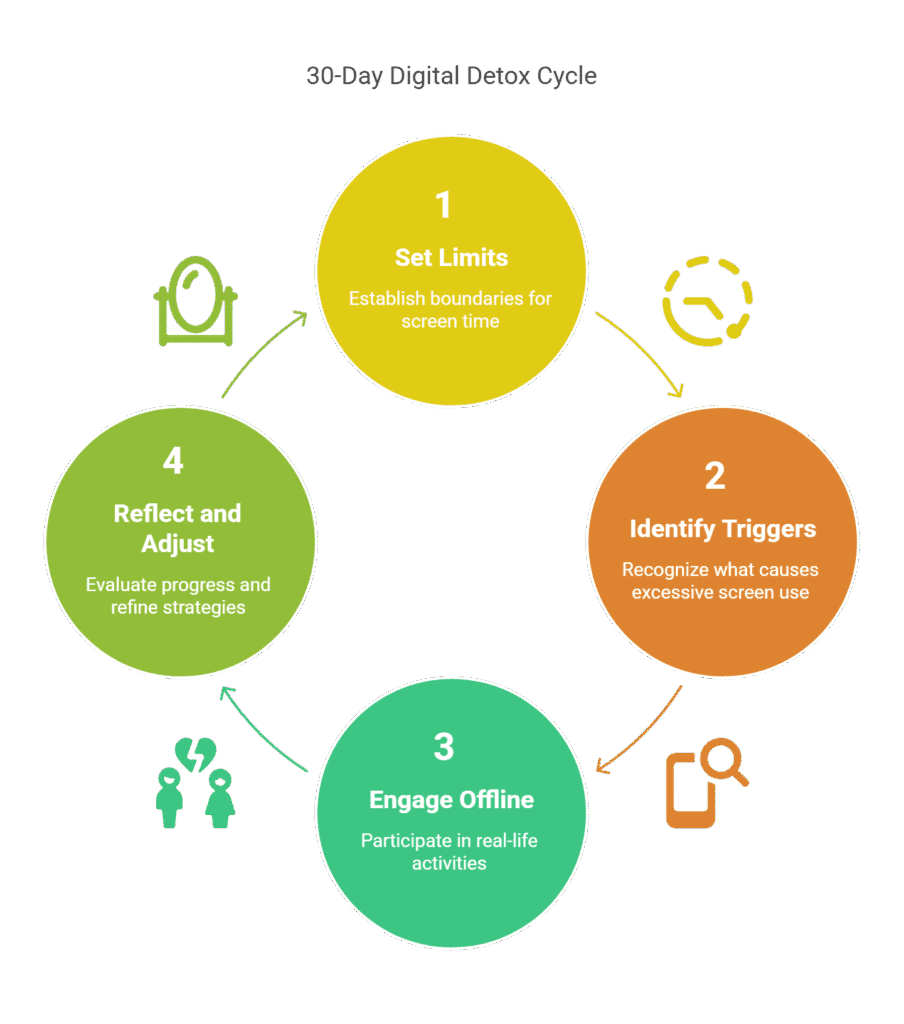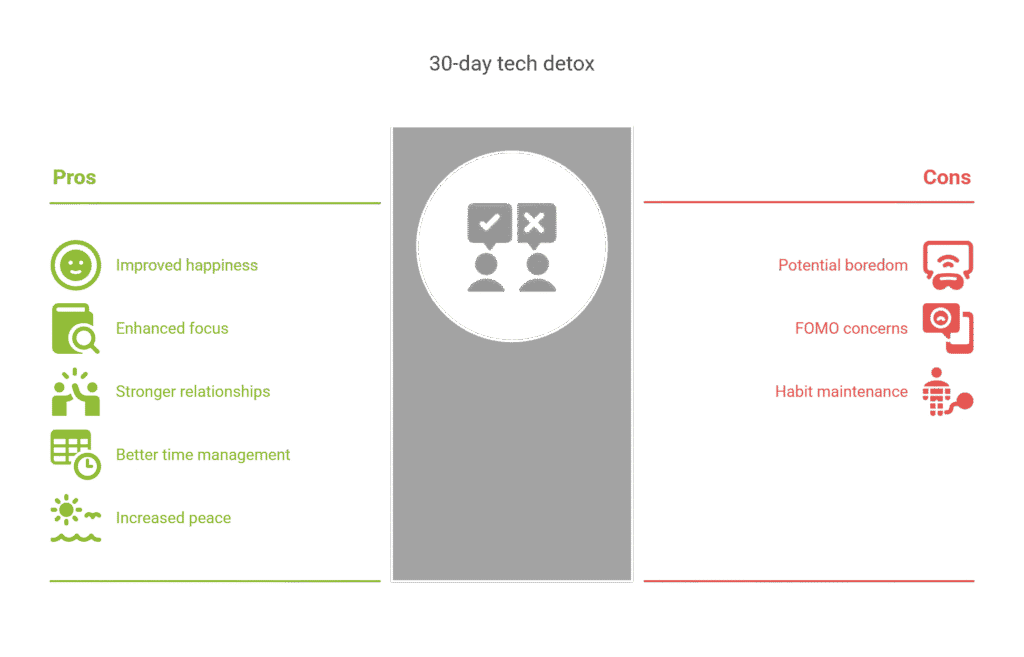What is the 30-day digital detox plan?

Digital devices are an important part of our lives these days, but being connected all the time can make us feel worn out and disconnected from reality. A 30-day digital detox plan challenge can help you break these harmful habits and feel better all around. It’s about setting limits, having a better relationship with technology, and putting real-life activities and interactions first.
People are being challenged to be more aware of how much time they spend on their screens, figure out what makes them spend too much time on their screens, and find a balance that lets them be engaged online and have important experiences offline. It’s not that we want to get rid of all technology, but that we use it in a smart way. Read this Harvard Health Publishing piece to learn more about how screen time can hurt your health.

Why You Should Take a 30-Day Digital Detox Plan
Before starting the plan, it’s important to know why you need to do a 30-day digital detox plan:
Lessens the stress and worry that come from having too many notifications and too much information.
Reduces exposure to blue light before bed, which improves the quality of sleep.
Gets rid of distractions to make you more productive.
Makes relationships stronger by letting people connect in a more present and meaningful way.
Let your mind roam and recharge to improve your creativity and mindfulness.
Heavy multitaskers have reduced memory. Stanford Report” (2018) What it says: People who frequently try to multitask with media tend to do worse on working memory and sustained attention tasks. How you can use it: Replace or support claims like “multitasking makes you remember 40% less” with “Stanford University research confirms that heavy media multitaskers underperform on memory and attention tasks compared to lighter multitaskers.”

How to Make Your 30-Day Digital Detox Plan
Start out small: Start by unplugging for small amounts of time and slowly extend the time.
Just be honest: don’t try to be perfect; instead, set goals that you can reach.
Turn off notifications: To cut down on interruptions, turn off alerts that aren’t necessary.
Get rid of apps that aren’t useful: Get rid of apps that don’t make your life better.
Instead of computer time, do things that matter: schedule in time for hobbies, exercise, or getting together with other people.
Mindfulness: Write in a journal or meditate to stay in the present and see how far you’ve come.

How to Get Ready for a 30-Day Digital Detox Plan Challenge
Set Clear Goals
Choose what you want to achieve: less time spent in front of a screen, better sleep, better relationships, or more work done. Writing down your goals will help you stay on track and keep you motivated.
Keep track of what you do online
Track how much time you spend in front of a screen with apps or a journal. This will help you see how far you’ve come.
Figure out what sets you off.
Know the feelings or events that make you use your phone or computer too much, like being bored or stressed. Being aware of these factors will help you stay sober.
Make people responsible.
Tell your family and friends about your plans, or look for a detox partner to help you both.
Plan things to do offline.
Make a list of fun things you can do offline, like reading, working out, cooking, or spending time with family and friends, to do when you would normally be online.

30-Day Digital Detox Plan: Week 1 Challenge to Kickstart Your Tech Break
Week one of the 30-day digital detox plan challenge is all about becoming more aware and starting to use technology less. Start by keeping a daily log, either with an app or by hand. Figure out when you use your computer the most and which apps take up most of your time.
Set small goals that you can reach, like limiting your daily time on social media by 30 minutes or turning off alerts for apps that you don’t need. Instead of going online, do something else, like reading, going for a walk, or doing a sport.
During this time, you’ll get a basic idea of your habits and start taking steps to change them. This strategy makes it possible for even bigger cuts to happen in the weeks to come. Google has a tool to help you control your screen time and learn about digital well-being.
Get an app that keeps track of your screen time.
Set time limits for each day for social media apps.
Make time every day for things you can do offline.
Turn off app alerts that aren’t necessary.
Set exact times to check your email.
The 30-Day Digital Detox Challenge Plan for the Second week
Build on your commitment in week two by focusing on longer times of being disconnected. Set up “no-screen zones” in your home, like the bedroom or the dinner table. Take a day off from social media and other apps that can be tempting. Do things that truly make you happy and calm down, like hiking, drawing, or spending time with people you care about.
This week is about rediscovering the fun of living a life away from technology and enjoying the rewards of less digital input, such as better sleep and more focused work. It’s a chance to really be in the present. Psychology Today has more information about how important it is to talk to people in person.
Set up “no-screen zones” in your house.
Try going “digital-free” for a day.
Enjoy your time with family and friends.
Do artistic things for fun or physical things.
Mindfulness can help you resist the desire to use technology.
The 30-Day Digital Detox Challenge Plan for the Third week
In the third week, you’ll work on sticking to your new habits and dealing with problems. Now, you should be able to tell that your energy and attention have improved. Keep setting limits and putting offline tasks first. Find ways to deal with any lingering triggers that cause you to spend too much time in front of a screen.
You might be looking because you’re bored or because you’re lonely. Actively plan other things to do during these times. This week, you should also look at your progress and make any necessary changes to your plan to make sure you stay on track to reach your total goal. Read on to learn how to set healthy limits with technology on Verywell Mind.
Figuring out what else causes too much computer time is important.
Come up with ways to deal with those events.
Think about the good changes that have happened so far.
If you need to, change your plan for a digital break.
Add new things to do offline.
The 30-Day Digital Detox Challenge Plan for the Fourth week
In the last week of the challenge, make sure your new habits stick and make a plan for how to keep them up in the long run. Look at what went well and what didn’t. Create a long-term plan for how you will use technology that you can keep up with after the 30 days are over.
Plan how you’ll use devices and when you’ll turn them off over the long run. Some ways to do this are to set time limits, plan “digital breaks,” or keep the no-screen zones going. It’s about building a healthy, purposeful relationship with technology that makes your life better instead of worse. Read what the Mayo Clinic has to say about making a digital health plan.
Make a long-term plan for your digital health.
Limit screen time in a way that you can actually stick to.
Plan to take regular “digital breaks” during the day.
Set up “no-screen zones” in your house.
Think about the trip and be proud of what you’ve accomplished.
“Digital Detox Strategies and Mental Health” (2025, PMC) by S. Setia et al.
What it says: Digital detox interventions are shown to improve outcomes like reduced stress, improved mood, less boredom, etc. How you can use it:When you talk about the benefits of planning for small detox habits (e.g., breaks, limits), back it with this:
“Studies show that digital detox strategies lead to measurable improvements in stress and mental health.”

FAQ Section—30-Day Digital Detox Plan
Q: Do I have to get rid of all technology?
A: No, the goal is not to completely give up technology. It’s to have a better relationship with it.
Q: What should I do if I need my phone for work?
A: Tell the difference between personal and work-related use. The diet is mostly about spending less time in front of screens.
Q: How can I keep from getting bored without my phone?
A: To keep yourself busy, plan things ahead of time, like reading, sports, or social events.
Q: Can I quickly check my phone?
A: Short checks are fine, but don’t get stuck scrolling for a long time. Set time limits for these kinds of things.
Q: Can I still watch TV?
A: Also think about cutting down on your TV time. The detox is meant to cut down on all kinds of excessive computer time.
Q: What should I do if I slip up during the 30-day digital detox plan challenge?
A: Don’t give up. You should think about what sets you off and return to your goals. The more you work, the more progress you should make.
Final Thought about the 30-Day Digital Detox Plan
A 30-day break from technology can be life-changing. You can improve your happiness, focus, and relationships by purposely spending less time in front of a screen and more time doing things in real life.
The goal of this task is not to get rid of technology but to use it more carefully. During this time, you can learn things that can help you change your digital habits for good, making your life more peaceful and satisfying. Taking on this task gives you the power to manage your time and energy well and focus on what’s important.
A 30-day internet detox is just the start. To keep making progress:
Review your internet habits often and change them as needed.
Are you ready to embark on your 30-day digital detox plan?
Share this guide with someone who needs a digital break too and drop a comment below telling us which habit you’ll start with! Let’s support each other on this journey.
Download Your Free 7-Day Digital Detox Tracker (PDF)
Want a complete roadmap? Download my Digital Detox Guide for step-by-step strategies to reset your mind and routines.
Disclaimer & Affiliate Disclosure: This content is for informational purposes only and is not a substitute for professional advice. Some links may be affiliate links, which means we may earn a small commission at no extra cost to you.
